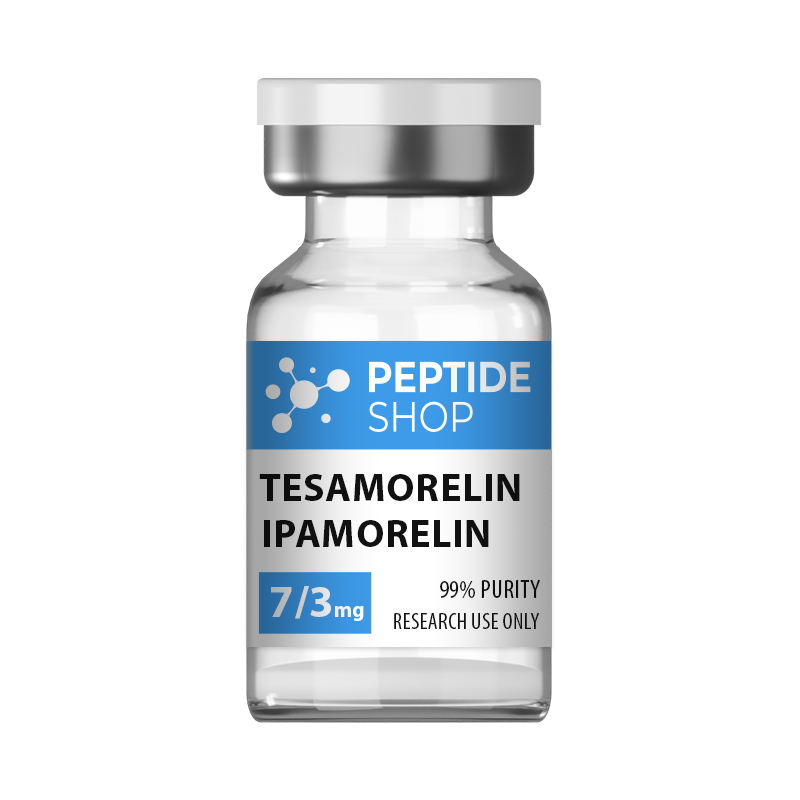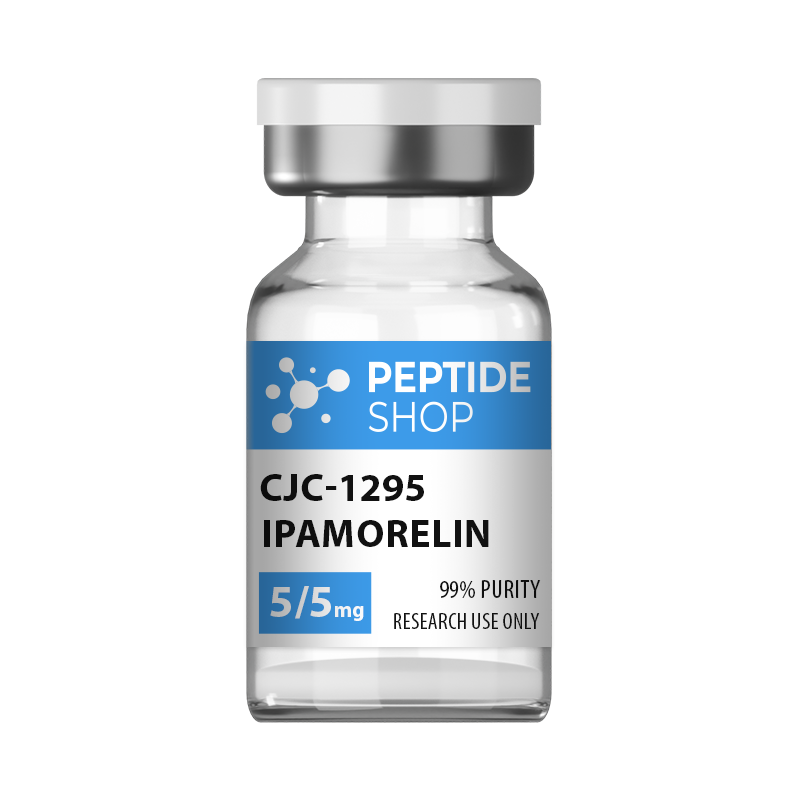Sermorelin and Ipamorelin Peptide Blend
In medical circles, Sermorelin and Ipamorelin are often mentioned as a fountain of youth. While no single ingredient has the ability to reverse the aging process and stop our cells from deteriorating, this blend has shown promising results in a laboratory setting.
Both ingredients are human growth hormone-releasing peptides that stimulate the pituitary gland. Based on the studies conducted on animals, they are believed to preserve youthful anatomy and psychology.
What is Sermorelin?
Sermorelin is a synthetically made version of GHRH, or growth hormone-releasing hormone, which is responsible for promoting the natural release of growth hormone. It works by binding GHRH to the anterior part of the pituitary gland, stimulating the natural production of GH.
When doing research on rats and primates, scientists came up with the following benefits:
Sermorelin was able to:
- Increase muscles
- Increase lean body mass
- Decrease body fat
- Boost recovery from training sessions and injuries
- Enhance joint health and flexibility
- Improve overall wellness and health
What is Ipamorelin?
As the previous compound, Ipamorelin stimulates the release of growth hormone while reducing the release of somatostatin. Based on laboratory research, Ipamorelin has demonstrated the following benefits in the domain of anti-aging:
- Increased bone density
- Loss of body fat in obese adults
- Increased muscle mass
- Better immune system
- Improved cellular protein synthesis
Sermorelin and Ipamorelin Blend
These two peptides are often combined because they are believed to slow down aging processes, increase muscle mass, minimize inflammation, decrease fat mass, and health the gut. Research in pigs indicates that Sermorelin minimizes cell death of cardiomyocytes, boosts healing after cardiac injury, improves the collateral blood vessels, and reduces inflammation.
In addition to this, the administration of ghrelin analogues and ghrelin has been shown to lower abnormal heartbeats.
It has also been found that Sermorelin and Ipamorelin can benefit the central nervous system and boost sleep quality in animal models.
References:
Bagno LL, Kanashiro-Takeuchi RM, Suncion VY, Golpanian S, Karantalis V, Wolf A, Wang B, Premer C, Balkan W, Rodriguez J, Valdes D, Rosado M, Block NL, Goldstein P, Morales A, Cai RZ, Sha W, Schally AV, Hare JM. Growth hormone-releasing hormone agonists reduce myocardial infarct scar in swine with subacute ischemic cardiomyopathy. J Am Heart Assoc. 2015 Mar 31;4(4):e001464. doi: 10.1161/JAHA.114.001464. PMID: 25827134; PMCID: PMC4579962.
Kanashiro-Takeuchi RM, Szalontay L, Schally AV, Takeuchi LM, Popovics P, Jaszberenyi M, Vidaurre I, Zarandi M, Cai RZ, Block NL, Hare JM, Rick FG. New therapeutic approach to heart failure due to myocardial infarction based on targeting growth hormone-releasing hormone receptor. Oncotarget. 2015;6(12):9728-39. doi: 10.18632/oncotarget.3303. PMID: 25797248; PMCID: PMC4496393.
Tokudome T, Otani K, Miyazato M, Kangawa K. Ghrelin and the heart. Peptides. 2019 Jan;111:42-46. doi: 10.1016/j.peptides.2018.05.006. Epub 2018 May 20. PMID: 29791869.
Shepherd BS, Johnson JK, Silverstein JT, Parhar IS, Vijayan MM, McGuire A, Weber GM. Endocrine and orexigenic actions of growth hormone secretagogues in rainbow trout (Oncorhynchus mykiss). Comp Biochem Physiol A Mol Integr Physiol. 2007 Mar;146(3):390-9. doi: 10.1016/j.cbpa.2006.11.004. Epub 2006 Nov 24. PMID: 17240179.
$100.00
| Quantity: | 10mg |
|---|---|
| Unit: | 1 vial |
| Contents: | Sermorelin + Ipamorelin |
| Form/Appearance: | Lyophilized/Powder |
| Peptide Purity: | 99% |
| Molecular Mass: | 3357.933 g/mol and 711.87 g/mol |
| Solubility: | Sterile / Bacteriostatic water |
FAQs
Related Products
Tesamorelin and Ipamorelin are two peptides combined in a blend that seems to be sharing the potential to stimulate the growth hormone axis, although through different mechanisms. This combination might activate the pituitary gland, which further results in the release of endogenous growth hormone. The blend seems to be showing positive effects on mammals and primates in terms of sleep, lipid profile, mean mass, muscle tissues, cognition, and metabolic function.
Chemical Structure
Molecular Formula
- Tesamorelin: C221H366N72O67S
- Ipamorelin: C38H49N9O5
Molecular Weight
- Tesamorelin: 5136 g/mol
- Ipamorelin: 711.9 g/mol
Sequence
- Tesamorelin: Unk-Tyr-Ala-Asp-Ala-Ile-Phe-Thr-Asn-Ser-Tyr-Arg-Lys-Val-Leu-Gly-Gln-Leu-Ser-Ala-Arg-Lys-Leu-Leu-Gln-Asp-Ile-Met-Ser-Arg-Gln-Gln-Gly-Glu-Ser-Asn-Gln-Glu-Arg-Gly-Ala-Arg-Ala-Arg-Leu-NH2
- Ipamorelin: H-Aib-His-D-2Nal-D-Phe-Lys-NH2
Tesamorelin and Ipamorelin Blend – GH Deficiency
Tesamorelin is an analog of the growth hormone-releasing hormone. It binds GHRG receptors on somatotrophs in the pituitary gland. Considering that it promotes the release of GH, Tesamorelin could boost lipolysis, reduce visceral adipose tissue, and potentially improve glucose metabolism.
Ipamorelin is a GHSR antagonist as well. However, it appears to be activating GHSR in the peripheral tissues and hypothalamus, potentially causing the release of GH. Researchers suggest that since GHSR stimulates the increase of GH secretion, it can promote lipolysis, protein synthesis, and IGF-1 production.
When combined, these two compounds target different components of the GH axis. This dual action seems to positively affect and amplify the overall GH, like insulin sensitivity, lipid profile, body composition, and overall metabolic function in a laboratory setting.
Tesamorelin and Ipamorelin Blend and Type 2 Diabetes
Research has shown that both Tesamorelin and Ipamorelin may help manage blood sugar levels and address metabolic issues in people with Type 2 Diabetes (T2DM). Tesamorelin works by boosting the body’s own production of growth hormone, which experts believe improves how the body responds to insulin and uses glucose. On the other hand, studies on Ipamorelin suggest it may positively affect insulin sensitivity and glucose regulation. When used together, these peptides could offer combined benefits, potentially leading to lower HbA1c levels, better insulin sensitivity, and reduced abdominal fat with T2DM.
Other benefits
- In animal models, this blend seems to have a positive effect on the following:
- Cognitive improvement – may improve memory and learning abilities.
- Muscle density – might enhance muscle density and size.
- Appetite and digestion – according to one research, animals that were given this blend managed to decrease their weight by 15%.
References:
Adrian S, Scherzinger A, Sanyal A, Lake JE, Falutz J, Dubé MP, Stanley T, Grinspoon S, Mamputu JC, Marsolais C, Brown TT, Erlandson KM. The Growth Hormone Releasing Hormone Analogue, Tesamorelin, Decreases Muscle Fat and Increases Muscle Area in Adults with HIV. J Frailty Aging. 2019;8(3):154-159. doi: 10.14283/jfa.2018.45. PMID: 31237318; PMCID: PMC6766405.
Clemmons DR, Miller S, Mamputu JC. Safety and metabolic effects of tesamorelin, a growth hormone-releasing factor analogue, in patients with type 2 diabetes: A randomized, placebo-controlled trial. PLoS One. 2017 Jun 15;12(6):e0179538. doi: 10.1371/journal.pone.0179538. PMID: 28617838; PMCID: PMC5472315.
https://pubchem.ncbi.nlm.nih.gov/compound/Tesamorelin#section=Deprecated-CAS
Stanley TL, Chen CY, Branch KL, Makimura H, Grinspoon SK. Effects of a growth hormone-releasing hormone analog on endogenous GH pulsatility and insulin sensitivity in healthy men. J Clin Endocrinol Metab. 2011 Jan;96(1):150-8. doi: 10.1210/jc.2010-1587. Epub 2010 Oct 13. PMID: 20943777; PMCID: PMC3038486.
https://www.sciencedirect.com/science/article/abs/pii/S1096637401902394?via%3Dihub
Epitalon is a synthetic peptide, made up of 4 amino acids – alanine, glycine, glutamic and aspartic acid. It’s based on a natural peptide epithalamion, commonly extracted from the pineal gland. Some earlier studies showed epitalon’s antioxidant potential, so more recent ones started focusing on its anti-aging potential.
Recent studies also showed its potential in regulating DNA changes, treating infectious diseases… even addressing some types of cancer.
Anti Aging Properties
The fact that epitalon is epithalamin’s extract, means it has the ability to eliminate free radicals that cause tissue damage. A particular research study on flies and mice showed that, after epitalon’s administration, fruit flies mortality rate dropped by a whopping 52%, while the mortality rate in rats dropped by 27%, as compared to the control studies. What researchers learned from this study was that regular epitalon administration stimulated the synthesis and secretion of melatonin, which inhibits free radical production and its subsequent damage.
There was another in vitro study on human somatic non-reproductive cells suggesting that epitalon peptide affects telomerase activity. Telomerase is an enzyme present in cells, allowing them to live longer. So, essentially, this study showed the researchers that this therapy leads to the prolonged cell lifespan. Of course, we still need full scale human studies to see the full extent of prolonged cell lifespan.
DNA Effects
Epitalon also interacts with DNA gene expression, allowing it to have an indirect effect on a whole host of potential bodily functions – from immune system, to skin, tendon and connective tissue repair.
This essentially allows epitalon peptide therapy to have a dual potential effect – on the one hand, it strengthens the immune system and protects the body from outside factors, and on the other, it allows the body to repair and regenerate its structures on its own.
Skin Cell Regeneration
We already talked about epitalon’s effect on DNA and genes. This effect extends to the fibroblast producing and maintaining MMP2. Interestingly, this peptide also affects other skin components, such as collagen and elastin.
Of course, we still have yet to see definitive human studies, but animal ones showed promising results. Young and old rats exposed to epitalon showed skin fibroblast proliferation of 29 and up to 45%. Not only that, epitalon also activates enzymes that slow down programmed cell death.
References:
Yue X, Liu SL, Guo JN, Meng TG, Zhang XR, Li HX, Song CY, Wang ZB, Schatten H, Sun QY, Guo XP. Epitalon protects against post-ovulatory aging-related damage of mouse oocytes in vitro. Aging (Albany NY). 2022 Apr 12;14(7):3191-3202. doi: 10.18632/aging.204007. Epub 2022 Apr 12. PMID: 35413689; PMCID: PMC9037278.
Anisimov VN, Mylnikov SV, Khavinson VK. Pineal peptide preparation epithalamin increases the lifespan of fruit flies, mice and rats. Mech Ageing Dev. 1998 Jun 15;103(2):123-32. doi: 10.1016/s0047-6374(98)00034-7. PMID: 9701766.
Khavinson VKh, Bondarev IE, Butyugov AA. Epithalon peptide induces telomerase activity and telomere elongation in human somatic cells. Bull Exp Biol Med. 2003 Jun;135(6):590-2. doi: 10.1023/a:1025493705728. PMID: 12937682.
CJC-1295 and Ipamorelin peptide are often used in conjunction as their action is synergistic and more than doubly effective. PeptideShop.com offers this blend in a total quantity of 10mg (5mg each).
CJC-1295 Peptide
CJC-1295 is a synthetic hormone-releasing hormone analogue and growth hormone secretagogue. It was developed by ConjuChem Biotechnologies as a means to promote regulation and pulsatile GH secretion. GH therapy is an FDA approved way of treating its deficiencies, diseases such as Turner or Prader-Willi syndrome, idiopathic short stature etc.
The only problem with this approach to treatment is it might be problematic to determine the effectiveness of these therapies due to lacks of biological serum markers. CJC-1295 peptide was developed to mitigate these problems and uncover a more potent and measurable way of secreting GH without affecting its pulsatile nature.
Ipamorelin Peptide
Ipamorelin is also a growth hormone secretagogue, but it also acts as a ghrelin hormone secretagogue receptor agonist, as demonstrated in both in vitro and in vivo studies. Even though its effect is similar to that of CJC-1295, the interesting thing about Ipamorelin is that it does not raise ACTH (Adrenocorticotropic hormone), or cortisol levels for that matter, making it the first GHTP receptor agonist with selective GH release ability.
CJC-1295 And Ipamorelin Peptide Blend
Rather than administering one peptide or the other, more and more research is aimed at testing out the synergistic effect of these two peptides. Some studies showed a 3 or even 5 fold increase in growth hormone secretion increase!
Both CJC-1295 and Ipamorelin will stimulate the pituitary gland to increase GH production and release more hormones through the bloodstream. Animal studies also demonstrated significant ghrelin stimulation, resulting in food intake, fat deposition and muscle building control.
Despite seeing these beneficial results in both GH secretion and appetite regulation, this therapy is still not an FDA approved treatment, as most of our data comes from animal studies. Definitive human studies are needed before moving into the realm of human consumption.
References:
Though we sell BPC-157 and TB-500 individually, we’re also offering this peptide blend to our customers. Both BPC-157 and TB-500 are body protecting compounds naturally occurring in the GI tract, and animal research showed that, when using them in combination, they help repair the GI tract, increase the rate of repair and development of new blood vessels and generally speed up tissue recovery and healing.
Though these peptides act effectively when applied individually, due to the nature of their mechanism of action, they do not compete against each other, but work in conjunction to offer far more superior effects. Of course, these effects have yet to be tested in human test subjects, but animal testing demonstrated high effectiveness in healing and repair.
BPC-157, TB-500 Blend Effects
As previously mentioned, this peptide blend is especially effective in healing and recovery, in animal studies. Here is what the researchers found:
- It helps with injury protection
- Boosts joint flexibility
- Speeds up regenerative processes within the body
- Increases the rate of new blood vessels forming
- Improves gut health and heals intestinal walls
- It may improve physical endurance
- Enhance brain health
- Boost muscle growth and repair damaged bones and joints
Though, individually, both BPC 157 and TB 500 express these effects, this blend supercharges them, allowing for far more powerful end results.
Sadly, we still don’t have many studies showing the effect of this blend in humans, this is why this peptide blend is only available for laboratory research and scientific experiments. But as these experiments continue to progress, we will soon have more information from human test subjects.
Wound and Injury Repair Studies
Studies involving BPC-157 and TB-500, both in combination and individually, clearly showed that these peptides stimulate wound healing and recovery and injury repair. Of course, the majority of these studies were done on animals, and this is where we’re getting our data.
These studies further showed this peptide blend being effective in complete recovery from bone, muscle, joints and connective tissues injuries. Furthermore, BPC-157 and TB-500 blend showed a substantial prophylactic effect, encouraging stronger, more elastic and more durable musculoskeletal structures.
Growth Hormone Effects
This blend’s muscle building and wound healing recovery effect is tied closely to its ability to interact with growth hormone, as shown in animal studies. BPC and TB have a synergistic effect in which BPC 157 accelerates the expression of GH receptors on fibroblasts, which increases the longevity of these cells; while TB 500 increases the rate of wound healing when these GH receptors get activated.
This synergistic effect is what scientists are counting on, to develop a potent wound healing treatment designed to be faster and more effective to those being employed currently. This is why we are eager to see what future development and human studies will show.
BPC-157 and TB-500 Blend Side Effects
When talking about human use, this is the most important question scientists are looking to answer – is this blend safe for human use and does it come with any side effects?
Fortunately for us, individually, these peptides showed safe for use and not dangerous at all; same goes for the blend. But we need to keep in mind that this information comes from animal studies, so until we get some definitive human test subject studies, we won’t know for sure.
Until that happens, PeptideShop.com is only selling BPC-157/TB-500 blend for laboratory research!
Retatrutide is one of the latest incretin mimetic drugs being tested for their weight reduction properties. Researchers use incretin mimetic agents as they work to mimic incretin hormones (gut peptides that get secreted after we eat) to allow for a better insulin secretion and hyperglycaemic control.
Even though there are numerous weight reduction agents being prescribed and used, FDA-recognized “treatment” for nonsyndromic obesity are:
- Orlistat
- Phentermine-topiramate
- Naltrexone‐bupropion
- Liraglutide and
- Semaglutide
With the exception of glucagon-like peptide 1 receptor agonists (such as semaglutide), most weight reduction agents come with a specific set of side effects such as nausea, gastrointestinal distress, abdominal pain, vomiting, diarrhea, or a general weight decrease that does not cross the 15% mark. Some of these medications even come with a warning against using them if a patient is suffering from a kidney, heart, thyroid or any related problems.
This is why scientists are turning more and more to retatrutide, because this incretin mimetic decreases appetite, promotes the feeling of fullness and slows down the process of gastric emptying, but does all that while presenting with minimal side effects and increased weight loss effectiveness, compared to liraglutide or semaglutide.
Retatrutide Mechanism of Action
Retatrutide exerts a powerful glucagon-receptor agonistic effect. When we compare it to human glucagon and glucagon-like peptide 1 (GLP-1), it exhibits:
- Reduced potency on the GCGR (human glucagon receptor) and GLP-1R (glucagon-like peptide-1 receptor)
- Enhanced potency at the human GIPR (gastric inhibitory polypeptide receptor)
When talking about in vitro experiments, retatrutide demonstrated similar efficacy in evoking glucose production within hepatocytes and inducing lipolysis. Also, retatrutide showed a favorable half-life of 6 days, enabling it a weekly dosage regimen (should the drug get FDA approved).
Another double-blind study conducted in the US on obese patients showed promising results. 338 adults in total were involved, split into 6 cohorts (depending on the weekly dosage), up against a placebo group. Retatritude group experienced the following results:
- 1mg group – after 24 weeks this group experienced weight loss of 7.2%, and after 48 weeks a total loss of 8.7%
- 4mg group (commencing with 2mg) – after 24 weeks this group experienced a weight loss of 11.8%, and after 48 weeks a total loss of 16.3%
- 4mg group (commencing with 4mg) – after 24 weeks this group experienced a weight loss of 13.9%, and after 48 weeks a total loss of 17.8%
- 8mg group (commencing with 2mg) – after 24 weeks this group experienced a weight loss of 16.7%, and after 48 weeks a total loss of 21.7%
- 8mg group (commencing with 4mg) – after 24 weeks this group experienced a weight loss of 17.9%, and after 48 weeks a total loss of 23.9%
- 12mg group (commencing with 2mg) – after 24 weeks this group experienced a weight loss of 17.5%, and after 48 weeks a total loss of 24.2%
In contrast, the placebo group only experienced a 1.6% weight loss after 24 weeks and 2.1% after 48. Findings also showed that adverse effects related to retratitude treatment (such as nausea, vomiting, diarrhea and constipation), were mild and depended on the dosage.
In conclusion, this peptide showed promising results in addressing obesity in both in vitro and human test subject studies. However, test samples were relatively small, and we still need more research and clinical trials to show the effectiveness of retratutide as an effective, long-term way of managing weight.
Reference:
Naeem M, Imran L, Banatwala UESS. Unleashing the power of retatrutide: A possible triumph over obesity and overweight: A correspondence. Health Sci Rep. 2024 Feb 5;7(2):e1864. doi: 10.1002/hsr2.1864. PMID: 38323122; PMCID: PMC10844714.

 Anti Aging
Anti Aging Hair Growth
Hair Growth Muscle Growth
Muscle Growth Peptide Blends
Peptide Blends Peptide Supplies
Peptide Supplies Peptides
Peptides Skin
Skin Testosterone
Testosterone Weight Loss
Weight Loss





